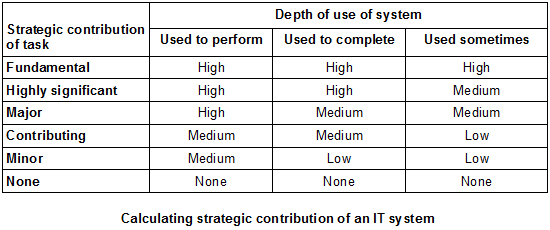
You can measure the strategic contribution of an IT system by thinking about two separate things: the strategic contribution of the work supported by the system, and the contribution of the system to the work.
To manage effectively, you need to focus on the important parts of IT, and take issues and risks more seriously in those areas. If you know which parts of your IT are less important, you can safely treat those areas as a lower priority.
Ideally, you want to know how much each IT system contributes to your organisation's strategy. But measuring the strategic contribution of IT is hard. Very few IT systems have a direct financial benefit, and even where they do, financial benefit is only one part of strategy. We often end up with simplistic measures - he who shouts loudest, or the systems owned by the most senior people.
At Metrici, we were faced with this problem when assessing systems at a health care organisation. We needed to adjust the priority of our recommendations to reflect the contribution of the systems to the organisation's strategy.
To achieve this, we asked a few simple questions about each system.
We asked what tasks the system supports - not the functionality of the system, but the human or business activity that the system supports.
We asked how much this task contributes to each of the areas of the organisation's strategy, such as patient care, compliance, finance, risk, and so on. These were not IT questions, but questions about the contribution of the work to each area of the strategy. We gave broad classifications, based on an estimate of the percentage of that strategic objective achieved by the task. The classifications we had were: none; minor (less than 2%); contributing (2% to 5%); major (5% to 10%); highly significant (10% to 20%); and fundamental (20% or more).
Lastly, we asked how much the task required the IT system. We used three grades: always used to perform the majority of the task; always used to complete the task; and sometimes used to complete the task. We made it clear that we were considering the system under normal circumstances, not what the organisation would do if it did not have the system.
We then took the highest task contribution, and cross referenced it to the depth of use of the system to get the overall strategic contribution of the system, using the table below.

Although far from perfect, this is a very practical method. When used across many systems, it gives a quick and defendable indication of the relative contribution of each. The model can be tuned and made more sophisticated, as you need. (One obvious area would be to add up the different strategic values - we just took the highest.)
The key to this approach is to recognise that IT is not of itself important. IT is only important because it helps the organisation perform a task that contributes to the organisation's strategy. Splitting the question into two - the strategic contribution of the work supported by the system, and the contribution of the system to the work - makes it much easier to estimate the strategic contribution of IT.